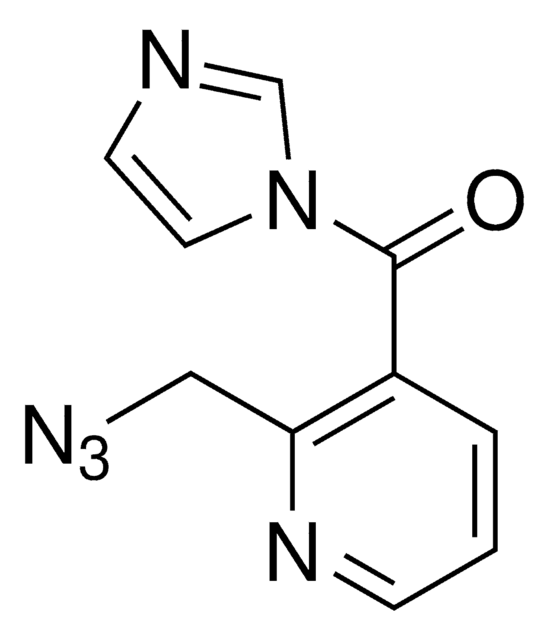おすすめの製品
形状
powder
品質水準
mp
68-72 °C
保管温度
2-8°C
InChI
1S/C10H9N3O/c1-8-9(3-2-4-12-8)10(14)13-6-5-11-7-13/h2-7H,1H3
InChI Key
OWQPEDNXDCVXJO-UHFFFAOYSA-N
アプリケーション
2-Methylnicotinic acid imidazolide (NAI or mNAI) is an RNA SHAPE probe for live-cell RNA structure profiling. SHAPE -- or selective 2′-hydroxyl acylation analyzed by primer extension -- uses small, electrophilic chemical probes to react with the 2′-hydroxyl group and provides insight to RNA structure and its dynamics in varied cells states or in cells with gene knockouts. It has also been extended to the SHALiPE approach, selective 2′-hydroxyl acylation with lithium ion-based primer extension.
その他情報
Conditional control of RNA-guided nucleic acid cleavage and gene editing
Guidelines for SHAPE Reagent Choice and Detection Strategy for RNA Structure Probing Studies
SnapShot: RNA Structure Probing Technologies
Structural Analysis using SHALiPE to Reveal RNA G-Quadruplex Formation in Human Precursor MicroRNA
Determination of in vivo RNA structure in low-abundance transcripts
Guidelines for SHAPE Reagent Choice and Detection Strategy for RNA Structure Probing Studies
SnapShot: RNA Structure Probing Technologies
Structural Analysis using SHALiPE to Reveal RNA G-Quadruplex Formation in Human Precursor MicroRNA
Determination of in vivo RNA structure in low-abundance transcripts
保管分類コード
11 - Combustible Solids
WGK
WGK 3
引火点(°F)
Not applicable
引火点(℃)
Not applicable
適用法令
試験研究用途を考慮した関連法令を主に挙げております。化学物質以外については、一部の情報のみ提供しています。 製品を安全かつ合法的に使用することは、使用者の義務です。最新情報により修正される場合があります。WEBの反映には時間を要することがあるため、適宜SDSをご参照ください。
Jan Code
913839-500MG:
913839-VAR:
913839-50MG:
913839-BULK:
試験成績書(COA)
製品のロット番号・バッチ番号を入力して、試験成績書(COA) を検索できます。ロット番号・バッチ番号は、製品ラベルに「Lot」または「Batch」に続いて記載されています。
Robert C Spitale et al.
Nature chemical biology, 9(1), 18-20 (2012-11-28)
RNA structure has important roles in practically every facet of gene regulation, but the paucity of in vivo structural probes limits current understanding. Here we design, synthesize and demonstrate two new chemical probes that enable selective 2'-hydroxyl acylation analyzed by
Shao-Ru Wang et al.
Nature communications, 11(1), 91-91 (2020-01-05)
Prokaryotes use repetitive genomic elements termed CRISPR (clustered regularly interspaced short palindromic repeats) to destroy invading genetic molecules. Although CRISPR systems have been widely used in DNA and RNA technology, certain adverse effects do occur. For example, constitutively active CRISPR
ライフサイエンス、有機合成、材料科学、クロマトグラフィー、分析など、あらゆる分野の研究に経験のあるメンバーがおります。.
製品に関するお問い合わせはこちら(テクニカルサービス)







